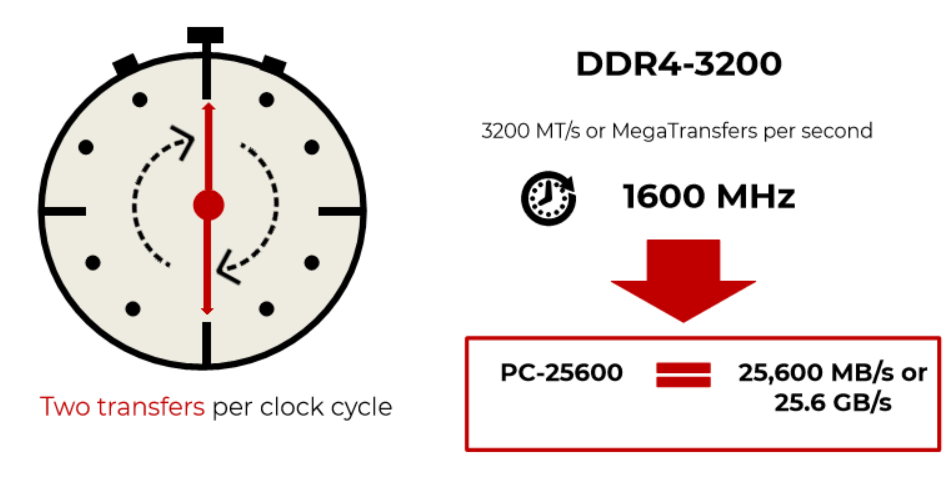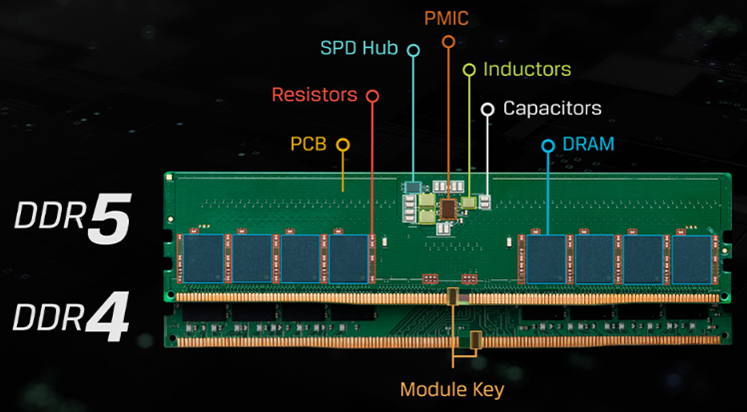Author
Published
10 Nov 2022Form Number
LP1618PDF size
6 pages, 505 KBAbstract
This article describes the DDR5 memory technology and its features, compares DDR5 to the previous generation DDR4 memory, and explains the benefit of DDR5 to customers.
What is DDR5?
DDR5 is the newest RAM available for Lenovo ThinkSystem servers. The DDR means “double data rate”, and the “5” means that this is the fifth generation of this type of RAM. New generations are released approximately every five years, with the original DDR RAM released in 1998.
Double data rate indicates that this type of memory performs two transfers per clock cycle. For example, DDR4-3200 memory performs 3200 MT/s, or MegaTransfers per second, with a clock speed of 1600 MHz. Since a transfer is 64 bits, or 8 bytes, wide, this memory can also be described as PC-25600, indicating a peak transfer speed of 25,600 MB/s, or 25.6 GB/s.

Figure 1. Double data rate memory
Comparing DDR5 to DDR4
DDR5 memory differs from DDR4 in many ways, including the following:
- Higher performance
The most important improvement in DDR5 is performance. Where DDR4 has an upper limit of 3200 MT/s, DDR5 starts at 4800 MT/s, and will ultimately scale to 6400 MT/s and likely beyond.
In addition, where DDR4 has a single 64-bit wide data channel per DIMM, DDR5 has two 32-bit data channels which can operate independently. The burst length – the number of data transfers made in a single operation – has been doubled in DDR5. These two changes mean that a DDR5 DIMM can fulfill twice as many CPU requests as a DDR4 DIMM in a given time, lowering latency and making DDR5 more efficient. Other changes, beyond the scope of this introduction, have also increased the speed of operation of DDR5.
- Lower power
DDR5 memory uses 1.1 V compared to the 1.2 V used by DDR4. This approximately 20% decrease in power will help reduce power consumption in servers and will generate less heat that needs to be removed from the system.
In addition, voltage regulation is now performed on the DIMM rather than on the motherboard, making it more efficient, more scalable, and less electrically noisy. RDIMMs (registered DIMMs), will use a 12 V input to the voltage regulator, whereas UDIMMs (unregistered DIMMs) will use 5 V. RDIMMs and UDIMMs cannot be mixed in a system.
- Higher capacity
DDR5 can use densities of up to 64 Gb DRAMs in a single-die package (SDP), where DDR4 maxes out at 16 Gb DRAM in an SDP. Higher device capacity translates to higher capacity DIMMs. DDR4 DIMMs can have capacities of up to 64 GB (using SDP), and DDR5 SDP-based DIMMs quadruple that to 256 GB.
Note that 3DS (3D stacked) DIMMs, with 3D stacked memory chips, allow 256 GB or even 512 GB capacity for DDR4 memory. The same technology will allow up to 2 TB DDR5 DIMMs. 3DS and regular DIMMs cannot be mixed in a system.
- More robust data integrity
DDR5 introduces an automatic on-die single-bit error correction (SEC) that fixes possible errors before outputting data to the controller. Error correction continues to the system level, where each DDR5 channel consists of 32 data bits and 8 ECC (error checking and correction) bits, compared to 64 data bits and 8 ECC bits for the single-channel DDR4.
DDR5 also supports an error check and scrub (ECS) function that allows early detection of possible DRAM failures to avoid or reduce downtime. ECS reads data and repairs it if required, then writes back the repaired data. The number and location of repairs is logged.
A feature called post-package repair allows a spare data area to be swapped in to replace a faulty data area.
DDR5 DIMMs that implement ECC are available in two types: 10x4 and 9x4. 10x4 means that the full 40 bits, 32 data plus 8 ECC, are implemented in each channel. In 9x4 DIMMs, each channel consists of 36 bits, 32 data bits plus 4 ECC bits. Since fewer ECC bits reduces the error detection and correction capability of these DIMMs, servers will likely use only 10x4 DIMMs. Non-ECC DIMMs have only the 32 data bits per channel, and will only be used in end-user devices. - Granularity
DDR4 DIMM sizes follow a 1, 2, 4 … progression – there are 16, 32, 64, and 128 GB sizes, but nothing in between. DDR5 DIMMs will have intermediate capacities as well, so, as an example, 48 GB and 96 GB DIMMs will be available.
- Different connector
DDR4 and DDR5 are physically compared in the figure below. The labeled parts of the DDR5 image include several abbreviations. SPD Hub is the Serial Presence Detect hub, which identifies the module and measures its temperature. The PMIC is the Power Management IC.

Figure 2. Major components of the DDR5 DIMM. Image courtesy of Kingston Technology Corporation; used with permission.As noted already, DDR5 uses a different operating voltage than DDR4, has a different architecture, and has the key slot in a different location. These factors make DDR5 and DDR4 physically and electrically incompatible.
Advantages of DDR5 For Customers
Adopting DDR5 has several advantages for customers.
- Performance – Now and in the Future
DDR4 has reached the limit of its performance. Initial DDR5 offerings are faster and more efficient than the latest DDR4, and will be even faster as technology improves. In addition, since the memory types are incompatible, choosing DDR5 means that the host must be a newer design, making it more future-proof than a design that uses DDR4.
- Capacity
DDR5 memory supports larger RAM devices than DDR4, giving a maximum conventional DIMM capacity of 256 GB. With 3D stacking, DDR5 DIMM capacities of 2 TB are possible. This is important for environments such as in-memory databases. Higher capacity DIMMs will allow servers to support much larger total memory capacity, with 16 TB for 8 DIMM slots as an example. In addition, the intermediate DIMM sizes mentioned above (48 GB and 96 GB) will allow customers to tailor system memory to their needs with a more granular approach.
- Lower Power Consumption
Lower power consumption at the single DIMM level is not very significant. For large data centers with hundreds of servers and thousands of DIMMs, the lower power consumption can be important. Not only do the DIMMs themselves consume less power, but less power is needed to cool them. The energy saved can make a sizeable difference over time.
-
Supported by Newer Lenovo Servers
Lenovo ThinkSystem V3 servers support DDR5 memory, both , with fourth generation Intel Xeon Scalable or AMD EPYC processors, . This includes servers with Intel and AMD processors, and in the rack, tower, ultra-dense, and mission-critical families. The high performance of DDR5 memory is needed to keep pace with newer processors, especially those with high core counts.
Trademarks
Lenovo and the Lenovo logo are trademarks or registered trademarks of Lenovo in the United States, other countries, or both. A current list of Lenovo trademarks is available on the Web at https://www.lenovo.com/us/en/legal/copytrade/.
The following terms are trademarks of Lenovo in the United States, other countries, or both:
Lenovo®
ThinkSystem®
The following terms are trademarks of other companies:
AMD and AMD EPYC™ are trademarks of Advanced Micro Devices, Inc.
Intel®, the Intel logo and Xeon® are trademarks of Intel Corporation or its subsidiaries.
Other company, product, or service names may be trademarks or service marks of others.
Configure and Buy
Full Change History
Course Detail
Employees Only Content
The content in this document with a is only visible to employees who are logged in. Logon using your Lenovo ITcode and password via Lenovo single-signon (SSO).
The author of the document has determined that this content is classified as Lenovo Internal and should not be normally be made available to people who are not employees or contractors. This includes partners, customers, and competitors. The reasons may vary and you should reach out to the authors of the document for clarification, if needed. Be cautious about sharing this content with others as it may contain sensitive information.
Any visitor to the Lenovo Press web site who is not logged on will not be able to see this employee-only content. This content is excluded from search engine indexes and will not appear in any search results.
For all users, including logged-in employees, this employee-only content does not appear in the PDF version of this document.
This functionality is cookie based. The web site will normally remember your login state between browser sessions, however, if you clear cookies at the end of a session or work in an Incognito/Private browser window, then you will need to log in each time.
If you have any questions about this feature of the Lenovo Press web, please email David Watts at dwatts@lenovo.com.
